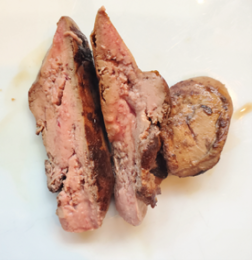Safe cooking of livers: information for chefs
Keep your customers safe from harmful bacteria by following the rules in your food control plan for handling and cooking livers. This page has more information to help you safely cook and handle livers.
Raw livers often contain bacteria such as Campylobacter and Salmonella. If liver isn’t cooked enough, bacteria will survive and make people sick. It doesn’t take much bacteria to make someone sick.
Campylobacter bacteria are often on the surface and inside of livers. If liver isn’t cooked enough, the bacteria will survive and can cause campylobacteriosis, a type of foodborne illness.
Many cases or outbreaks of campylobacteriosis are due to restaurants or caterers serving undercooked livers and liver products, including:
- sliced or whole lamb livers
- chicken livers
- chicken liver mousse or pâté.
Campylobacteriosis can be very serious and lead to hospitalisation
- Symptoms of campylobacteriosis include vomiting, diarrhoea or bloody diarrhoea, head and body aches.
- Symptoms can last up to 7 days.
- Elderly, very young, or immunocompromised people are more likely to get very sick.
- In rare cases, it can cause severe long-term illness, such as Guillain-Barré Syndrome (GBS). GBS causes the body's immune system to attack the nerves.
Find out more about campylobacteriosis
Contamination is not obvious
- You can’t see or smell Campylobacter and Salmonella and they don’t occur evenly on or in liver.
- New Zealand Food Safety testing shows that Campylobacter can be found inside and outside of livers.
- Cooking livers to an internal temperature of 75°C for 30 seconds will kill the bacteria present.
| Undercooked | Undercooked | Cooked correctly |

|

|

|
|
Undercooked chicken liver cooked to 55°C, still bloody in the middle. |
Undercooked chicken liver cooked to 60°C, still bloody in the middle. |
Chicken liver cooked to safe internal temperature of 75°C, still pink in the middle. |
Examples of what can go wrong and how to prevent it
What can go wrong
- Undercooking: not cooking livers long enough means harmful bacteria in the middle won't be killed. Some believe thoroughly cooked livers will be dry, but careful cooking can make them both safe and tasty.
- Cross-contamination: raw liver juices can contaminate other foods if livers aren't kept separate. Hands and equipment that haven't been cleaned and sanitised can contaminate food.
How to prevent things going wrong
- Cook liver so the thickest part reaches 65°C for 15 minutes, or 70°C for 3 minutes, or 75°C for 30 seconds.
- Store raw liver in a container on a lower fridge shelf to cooked foods so it doesn't drip onto other food. Use different utensils and different surfaces for raw and ready-to-eat foods.
- For frozen livers: defrost all the way through before cooking.
- Fry livers in small batches: Ensure each liver is in contact with the hot surface of the pan.
- Check temperature: Fry livers in a hot pan until the middle of the thickest part reaches 65°C for 15 minutes, or 70°C for 3 minutes, or 75°C for 30 seconds. Use a probe thermometer to check the temperature of the centre of the thickest part of the liver. These methods are the most reliable way to ensure the livers are cooked. Checking for a change in liver colour is not a reliable indicator of safety. You don’t need to check the temperature of thinly sliced or unformed minced liver.
- Prepare pâté safely: Fry the livers and then finish cooking them in a water bath. Ensure the water bath is hot enough that the middle of the thickest part of the liver reaches 65°C for 15 minutes, or 70°C for 3 minutes, or 75°C for 30 seconds.
- Wash your hands. Hands can spread bacteria from raw food and dirty surfaces to other food. Wash your hands with soap for 20 seconds, rinse, and dry hands on a clean dry towel or paper towel before preparing food and after handling raw ingredients. Use clean utensils for ready-to-eat foods instead of hands.
- Use dedicated equipment: Use separate equipment for raw poultry and livers that isn’t used for other foods.
- Prevent leaks: Ensure juices from raw liver don’t leak onto other foods.
- Be aware that rinsing dirty equipment with high-pressure taps in the sink can spray bacteria around the kitchen: Dip the plastic recyclable liver packaging in soapy water or rinse the packaging outside the kitchen so raw liver juices and bacteria don’t spread to other surfaces.
- Clean and sanitise equipment: After use, clean and sanitise thermometers, cutting boards, knives, and other utensils that have come into contact with raw liver.
- When using gloves to prepare raw liver: Remove the gloves before touching other food or surfaces. When you have finished handling the liver, carefully peel gloves off over a rubbish bin. Wash your hands immediately after taking off the gloves.
Share this information
We've prepared a fact sheet and poster with the same information on this page. Download and print them to use in your workplace.
Safe cooking of livers: information for chefs – fact sheet [PDF, 476 KB]
Safe cooking of livers: information for chefs – poster [PDF, 1.1 MB]








